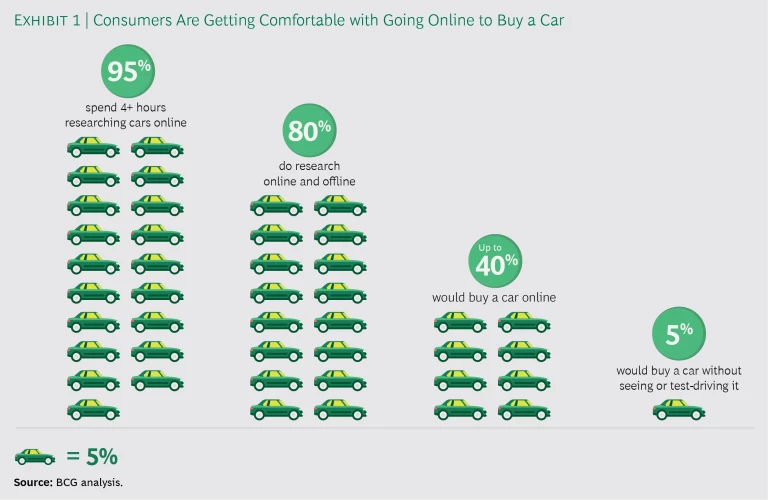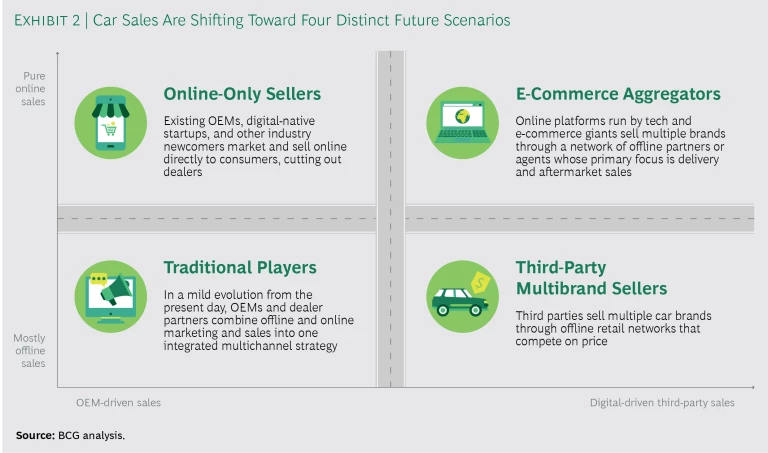Imagine picking out a car from a vending machine and using your phone to pay for it.
Such a car shopping experience may sound futuristic, but it already exists. Since Carvana built its first used-car “vending machine” in 2015, the Phoenix-based company has opened 13 of the glass-enclosed structures, which look like parking garages and can hold up to 30 vehicles. Drivers choose the car they want from the company’s website and go to the appropriate physical location to pick it up. In 2017, a Singapore luxury-car dealer opened what it claims is the world’s tallest auto vending machine, a 15-story tower that displays up to 60 used BMWs and Bentleys. Those services are limited to used cars, but Chinese e-commerce giant Alibaba has begun opening technology-based kiosks to sell new vehicles.
Everything about cars is changing, from how companies design and build them to who owns them to who drives them. As the preceding examples show, how companies sell cars is changing too. As more consumers shop online and find it natural to buy almost anything from their phones, original equipment manufacturers (OEMs) and auto dealers are experimenting with alternatives to traditional sales, including near-online-only and direct sales.
The stakes are high. Automakers that take the wrong steps—or cling to the status quo—risk losing a large portion of their revenue and profits, while those that make the right moves could see their revenue and profits expand. If they aren’t already doing so, automakers must adopt bold measures to ensure that they and their dealer networks are well positioned to accommodate future auto trends, regardless of how events play out. This entails making existing sales channels as efficient as possible while simultaneously experimenting with new sales and marketing methods.
Car Shoppers’ Expectations Are Changing
The growth of mobile devices, e-commerce, and social media has changed the ways people shop. Today, when consumers research products ahead of a purchase, they are likely to look beyond traditional information sources to new forms of guidance and recommendations, including social media and social media influencers. When they are ready to buy—whether it’s a dinner, a sweater, or a vacation—they expect services that make shopping convenient and fast, owing to their interactions with e-commerce giants such as Amazon and Alibaba. Consumers’ twin expectations of efficient service and instant gratification are now spilling over into their views about buying bigger-ticket items, including cars.
In particular, changing sentiments are reshaping how consumers spend the time they devote to car shopping. Gone are the days of browsing through classified ads to identify available options or making multiple trips to a dealer’s lot to look at vehicles there. In a recent BCG survey of 3,000 car shoppers in various parts of the world, we found that the vast majority (95%) spend more than four hours doing research online before they ever visit a car dealer. (See Exhibit 1.) We also found that four out of five car buyers jump between browsing for information online and visiting dealers or other auto sellers. Another change is that they don’t visit dealers as often, a sign of dealers’ diminished impact. Over the past decade or so, total dealer visits per sale have dropped from about four to 1.4.
Shifting preferences are also leading consumers to consider alternative methods of purchasing and paying for a car. In Asia, for example, approximately 40% of respondents to our survey said that if they were to buy a car in the next five years, they would be willing to order and pay for it online; in South America, the corresponding number is close to 25%. Even so, only 5% of consumers said that they would be willing to buy a car without seeing or test-driving it, a clear sign that offline channels remain vital in the purchase process.
As the number of dealer visits per car purchase drops, the traditional car-sales funnel is changing dramatically. With upstream activities moving online, OEMs have more opportunities to interact directly with end customers—and to collect information such as a prospect’s specific interests or needs, which could be used as sales leads. In addition to collecting such information through their own websites, OEMs can obtain it from the dealers, aggregators, or financing companies they work with.
Consumer sentiment is not the only thing affecting auto retailing. Ride-hailing services such as Uber and Lyft operate in large parts of the world and have changed attitudes about car ownership, which could drastically affect sales and eventually lead to fleet sales playing a larger role in the industry.
Technological advances are also reshaping automakers’ relationships with consumers. By analyzing data collected from connected-car systems and digital components, automakers can create a more direct relationship with consumers than was possible in the past, when dealers were car buyers’ closest contacts. For example, by inviting consumers to sign up for test drives through its website, an OEM can collect data about the make, models, and features that each potential buyer prefers, and it can use the information to ensure that the shopper’s preferred model is on a dealer’s lot in time for a test drive, improving the odds of making a sale. Automakers can also aggregate and anonymize the information they collect on car shoppers with existing data on consumer preferences to make more informed recommendations of other vehicles that individual consumers might be interested in. The connection can continue after a sale, as the company continues to collect data through the vehicle’s connected-car systems. The OEM can use that data to proactively recommend maintenance or suggest other aftermarket purchases.
The Four Future Scenarios of Auto Retailing
Changes in consumer preferences and advances in technology offer car companies the chance to modernize their business models and launch projects to better serve consumers’ needs. But those same factors pose major threats to existing retail channels for both automakers and their dealer partners. Current trends are shifting toward four distinct retail scenarios. (See Exhibit 2.) While we believe that all four will exist to some degree in the future, it is not clear which one will account for the largest portion of sales. If newcomers capture significant market share from more established players, it could lead to a rebalance of power in vehicle sales. For this reason, automakers must be prepared to address all four scenarios.
The most recognizable scenario is the one most typical of auto sales today—namely, sales that occur mainly offline under the control of traditional OEMs and dealers. In a related future scenario, existing OEMs and dealers could build on their current standing to move more sales online. Such enterprises could include online-only ventures by car companies that begin as separate divisions or spinoffs created to sell a new brand or model in order to avoid compromising existing dealer partnerships. An example of that approach is Lynk & Co, created by Chinese automaker Geely Automotive, which also owns Volvo. Geely started the online-only Lynk & Co sub-brand to market a new compact SUV built on Volvo chasses and engines; it began selling the cars in China in 2017, and will expand into Europe and the US in 2020.
In the future, third parties that are neither automakers nor dealers could disintermediate existing industry players by selling multiple brands. This change could happen in either of two ways. In one scenario, companies could create a website to help consumers research and buy new or used cars; buyers could then pick up their vehicles at an auto dealer or dealer network that is affiliated with the site and pays it a finder’s fee. US companies such as TrueCar and CarGurus operate such services.
In the other scenario, e-commerce aggregators could add auto sales to the ever-expanding universe of products they sell online through their existing e-commerce marketplaces. Alibaba already does this. The company has launched “super test-drive centers” in Shanghai, Nanjing, and Guangzhou through its Tmall e-commerce platform and Taobao mobile app. Drivers who have good credit scores can use facial-recognition technology to sign up for a three-day test drive of models from Ford and other participating automakers. According to the company, the sign-up process takes about 10 minutes. Alibaba expects to open similar auto vending-machine-type centers in Beijing, Hangzhou, and elsewhere in coming months, and it may make the technology available industry-wide in the future.
The rewards for successfully navigating the new retail landscape for auto sales may be very large indeed. By 2035, e-commerce aggregators and other new forms of auto retailers could gain enough traction in the market to put up to 30% of OEMs’ present revenue at risk. On the other hand, OEMs that generate new revenue streams from data, connectivity, on-demand mobility, and other innovative services could increase their current revenue by as much as 20%.
Merging into the Auto Retailing Fast Lane
To be on the winning side of coming trends, carmakers and their dealer partners should pursue two strategic efforts. One is to take no-regret steps to make existing sales operations and networks as lean and productive as possible—moves that will be beneficial to the company regardless of what the future holds. The other, simultaneous effort is to devote resources to experimental test-and-learn ventures that will help them prepare for more radical industry developments. In both cases, companies should aim to extensively leverage data and predictive analytics to determine the best course of action.
No-Regret Moves. Starting at the beginning of the sales funnel, automakers and dealers must improve the way they generate sales leads. Although automakers and dealers already use digital networks to generate leads, they don’t coordinate those activities to the extent that they should, which results in lost opportunities. Partners need to adopt more structured communications to improve their collaboration. They also need to update their lead-generation tools to include social media monitoring and personalized marketing of services.
Another key action that car companies should take is to make their dealer and internal retail networks leaner. Right-sizing retail operations can make those operations more efficient and agile, improving single-store and overall economics. To proceed pragmatically, car companies should conduct a systematic performance review of existing retail locations with the aim of right-sizing square footage and staff size on the basis of existing sales volume and probable future sales. In determining how much space a retail location needs, consider the types of in-store experiences that each location will offer in the future.
As part of their effort to right-size retail locations, car companies should reconsider their practice of operating all-under-one-roof retail stores in favor of operating segmented physical locations designed to meet different customer needs. Traditionally, companies combined new and used car sales, service centers, and back-end operations at a single location. That’s not always necessary, and in some cases it could hurt sales. For example, car buyers in the city might not want to travel to a suburban auto mall to look at new vehicles. Opening small showrooms in high-traffic city malls, service centers outside the city, and a centralized facility for back-end operations in lower-density areas can bring services closer to the places where people want them and reduce overhead by curbing needlessly expensive property leases.
One automaker taking a segmented approach is Mercedes-Benz, which has opened Mercedes Me concept stores in central locations in Munich, Moscow, Melbourne, and five other cities. The primary function of these outlets is to introduce potential customers to the brand. Combining elements of a café and a showroom, the stores serve coffee, host events, and include a Mercedes vehicle as part of the décor. Digital displays and brand specialists share information and answer questions about specific car models. Mercedes is also operating after-sales service outlets near airports on an experimental basis to better address new customer needs and expectations.
Another no-regret move is to use data analytics to make decisions such as where to locate new retail stores. OEMs can map out an ideal network of store locations after analyzing multiple data layers, including demographics, local competition, and car registrations. Then they can match that data against existing locations to identify priorities for expanding existing facilities, opening new locations, and closing underperformers. Adopting this type of analytical approach can help operating teams by moving decision-making tools and processes to the local level.
In addition to pursuing initiatives that focus on physical locations, automakers must expand online sales. Part of that task involves establishing clear goals for an online presence and setting a strategy for accomplishing those goals. In doing so, it is important to gradually integrate online and offline channels to create a seamless value proposition for end customers. A key objective in the process is to ensure that existing IT systems can handle data from multiple sources and keep it secure. If data from online and offline sales leads, connected-car systems, and other sources currently feeds into different databases, OEMs that lack integrated systems may not be able to connect the dots and capitalize on all of the available data. Our client experience indicates that many auto OEMs underestimate the difficulty of merging such customer information from different sources and, as a result, struggle to unlock the full value of omnichannel initiatives.
Test-and-Learn Ventures. While taking steps to streamline marketing and sales, OEMs and dealers must also devote resources and personnel to testing new projects to prepare for the various future scenarios that could take over the market. Projects should incorporate agile ways of working so the organization can generate ideas, test them, and adapt quickly to changing environments or market trends.
High on the list of test-and-learn priorities are pilot e-commerce projects to expand a company’s online presence. Possibilities include launching a new model vehicle through an existing or new online platform, partnering with an e-commerce marketplace on a broader selection of products in specific markets, and responding creatively to new consumer retail preferences. Because they have so many options, companies should ask themselves a series of questions to help determine the best way to achieve the results they want. (See Exhibit 3.)
Looking to other industries for inspiration can be worthwhile. Not so long ago, apparel companies thought that barriers to selling online—including customers’ desire to touch and feel items before deciding to buy—were too formidable to conquer. But new digital tools that show consumers what a pair of pants or skirt would look like on their body type have helped remove the old barriers. Those tools, along with quick checkout, free delivery, and easy return policies, have made shopping for clothes online a mainstream practice, effectively revolutionizing the apparel industry.
Just as fashion retailers developed online tools, automakers should continue to experiment with digital technologies that could help car shoppers put themselves in the virtual driver’s seat of a new or used vehicle. Online car buyers, for example, might gravitate toward virtual showrooms, while people shopping at a dealer might respond well to AR technology that lets them view new car features or see what a car would look like in a different color.
Another possible project could involve creating a new customer-centric product or service—an app that guides a person through buying or financing a car, for example, or one that schedules oil changes or other regular maintenance. Apps can serve a dual purpose: they can help shoppers or car owners handle specific tasks, and they can give the company direct insight into consumers’ preferences and behaviors, which the company can use to solidify the relationship.
OEMs can also test new sales methods, such as the highly automated vending-machine sales model that Carvana helped pioneer, or a showroom-based sales model similar to those operated by Hyundai and Tesla. Small pilots in select geographical locations or limited to a few vehicle makes or models could enable the company to gauge the potential success of such an alternative sales model and the feasibility of rolling it out on a wide scale. BMW is experimenting with two geography-based wholesale models for selling its i-series electric vehicles. In the US and China, the company sells i-series vehicles through dealers or agents who take physical possession and ownership of the cars and handle customer invoices and delivery. In France, Germany, and the Netherlands, however, while BMW agents handle i-series model deliveries, the company maintains responsibility for invoicing consumers.
Another possibility is to team up with a multibrand dealer group or aggregator platform to launch a pilot program that capitalizes on the increased market power of such a partnership. In July 2018, Ford began selling cars at an outlet of the UK-based Next retail chain in Manchester through a partnership with UK-based auto seller Rockar.
Finally, car companies can try offering new forms of car ownership that satisfy urban mobility needs, such as a ride-sharing platform or an autonomous fleet. In one example of this, automakers including Cadillac, Ford, Porsche, Volvo, BMW, and Mercedes are testing car subscription services in a handful of US cities, offering use of a vehicle for a monthly fee that covers insurance, roadside assistance, maintenance, and the option to trade in the vehicle for a different model on short notice.
What’s Next? Four Guiding Principles for the Journey Ahead
To map out their responses to future trends, automakers and dealers need to create a transformation plan that incorporates both no-regret moves and test-and-learn ventures. The plan should be consistent with the company’s current brand positioning while taking into account ongoing industry trends. It should aim for the long term—not two to three years out, but closer to five to ten. We recommend taking several other important factors into account when formulating a plan.
Include contingencies to fast-track changes. OEMs should build into their transformation plan the ability to fast-track changes in response to unexpected major market disruptions that threaten the status quo. A disruption could be a new market entrant, such as Tesla when it shook up the industry by selling high-end electric cars from showrooms in suburban shopping malls. Or it could be the appearance of new technology, such as a virtual-reality system that car shoppers could use one day to test-drive a vehicle without leaving home, making real-life test drives less relevant. As automotive technology advances on multiple fronts, predicting exactly what could happen and when it could happen is difficult. As a result, the burden is on car companies to have a blueprint in place for changing their plans as needed. Hyundai’s experiment with direct sales in the UK is an example of this. For several years, Hyundai operated showrooms in upscale UK shopping centers through a partnership with Rockar as a way of expanding its presence there. After proving that mall-based outlets improved foot traffic, and in response to similar moves made by other car companies, Hyundai in early 2018 opted to run the showrooms on its own, assisted by a local UK dealer.
Improve monitoring of retail trends. Consumer expectations about shopping continue to evolve with regard to how they want to buy goods and services and how they want to pay for them. In response, car companies must upgrade the way they track trends in order to stay abreast of relevant buying patterns and habits. Because e-commerce, retail, mobility, and other industries influence consumer expectations about car shopping, car companies’ market research must extend beyond the auto industry to monitor what’s happening in those other areas. Companies that lack such a research capability need to build it up.
Make people a key part of the transformation. New ways of selling require personnel who have new skills. Automakers and dealers must work together to invest in training and technology to help existing personnel—in particular, dealer sales personnel—obtain those skills. In bygone days, dealers needed salespeople who not only knew a lot about the cars they sold but also were comfortable using aggressive tactics to close a deal. As consumers do more of their own research before visiting a showroom and want a more collaborative experience, dealer personnel must develop appropriate customer-service skills. We see auto dealers’ showroom staff operating in a similar manager to Genius Bar staffers in Apple retail stores, answering questions about product features and options, and providing customers with other concierge-style support. In the auto industry, companies such as Tesla already employ in-store concierges.
Work collaboratively with existing sales channels. Automakers’ work with dealers must go beyond retraining existing personnel. As automakers pursue more direct relationships with customers and as they experiment with different sales formats, dealers remain an important link in the auto supply chain. Consequently, as the relationship between OEMs and dealer networks evolves, they must continue to collaborate on innovations, such as designing and implementing new digital tools to manage leads and improve data sharing. For example, the partners might decide together how to invest in and deploy augmented reality technology to support virtual test drives. If automakers are planning to roll out iPads for sales and marketing personnel, they should consult with dealers about what content to put on the devices. It’s easy to see the value of moving activities such as booking test drives online, but only by working together and sharing data can carmakers and dealers make that happen.
Evolving consumer shopping preferences are changing auto retailing—and with it, automakers’ and dealers’ traditional roles. Although car companies will continue to work with dealer networks in some capacity, they can’t ignore the opportunities that new sales channels offer. Investigating these opportunities will encourage car companies to take a more active role in the presales funnel, including steering lead generation. Such a step could push OEMs to restructure their dealer networks to meet their needs in the future more successfully. Even then, OEMs and their partners must continue to look for ways to collaborate, improve communication, and better serve their customers.







